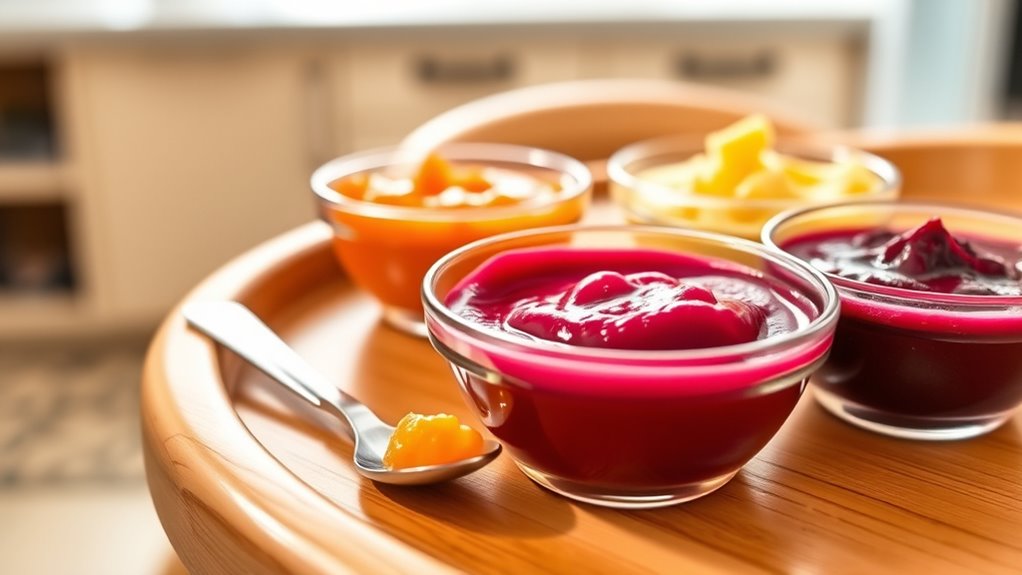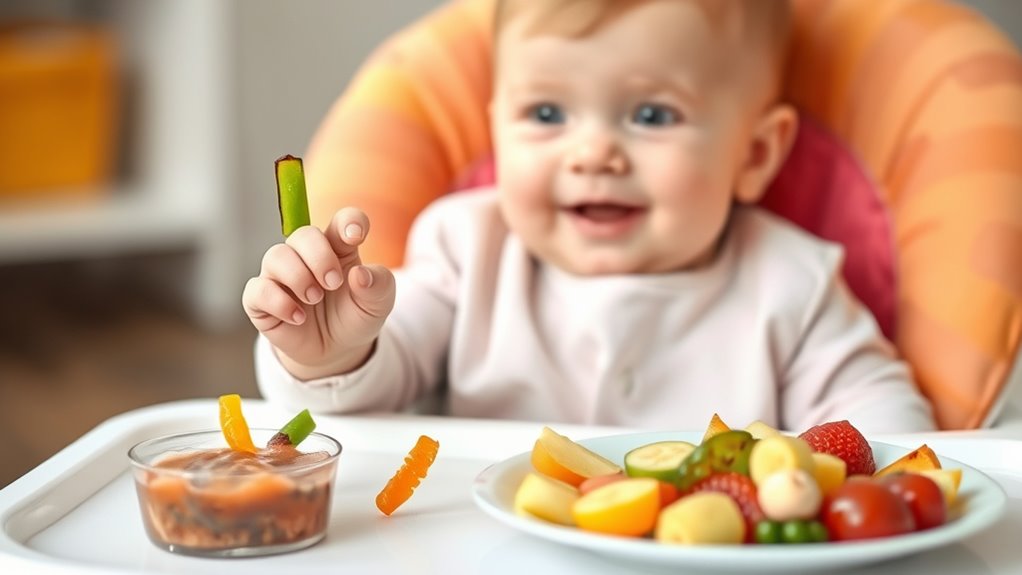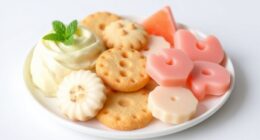When your baby shows signs like sitting supported, good head control, and curiosity about food, it’s time to introduce solids. Start with single-ingredient purees, ensuring they’re smooth and at a safe temperature. As your baby progresses, gradually offer small, soft finger foods like cooked vegetables or pasta. Always supervise meals closely, cut foods into small pieces, and introduce new options one at a time. Keep mealtimes positive—continue to explore helpful tips on making the progression seamless and safe.
Key Takeaways
- Begin with smooth, single-ingredient purees like vegetables, fruits, and cereals, gradually introducing new foods one at a time.
- Watch for developmental cues such as sitting supported and showing curiosity, indicating readiness for solids.
- Transition to soft finger foods like cooked vegetables and small pasta to promote self-feeding and motor skills.
- Ensure foods are cut into small, manageable pieces and serve at safe, warm temperatures to prevent choking and burns.
- Maintain a positive mealtime environment with supervision, routine, and patience to support your baby’s feeding development.
Signs Your Baby Is Ready for Solids

You’ll want to start solids when your baby shows certain signs of readiness. Look for developmental milestones like sitting up with support, good head control, and showing curiosity about your food. If your baby reaches out for your spoon or watches you eat intently, they’re signaling interest in family meal integration. Another key sign is the ability to move food to their mouth and swallow it rather than pushing it out. These cues indicate they’re physically prepared and interested in trying new textures. Introducing solids at this stage supports their developmental growth and helps them develop feeding skills. Waiting for these signs guarantees your baby is ready, making the transition smoother and more enjoyable for everyone involved.
Choosing the Right First Foods

When selecting your baby’s first foods, it’s important to prioritize options that are nutritious, easy to digest, and safe for their developing digestive system. Focus on feeding milestones to introduce simple, single-ingredient foods like pureed vegetables, fruits, and iron-fortified cereals. These options help your baby build a taste for solids and support early nutritional needs. It’s also a good time to contemplate allergen introduction, such as small amounts of peanut or egg, based on your pediatrician’s advice. Starting with gentle, non-irritating foods reduces the risk of adverse reactions and promotes healthy eating habits. Remember, patience is key—observe how your baby responds to each new food, and gradually expand their options as they grow more comfortable with solids. Incorporating developmentally appropriate toys can support your child’s motor skills as they begin to explore new textures and tastes. Being aware of grocery savings strategies can help you access a wider variety of nutritious foods while managing your budget effectively. Additionally, understanding best practices for food safety can prevent contamination and ensure your baby’s health as they transition to solid foods. For example, ensuring that all foods are prepared and stored properly aligns with halal dietary practices, which emphasize cleanliness and specific ingredient guidelines to keep your baby safe.
Preparing and Serving Purees

When preparing purees, aim for a smooth, spoonable consistency that’s easy for your baby to swallow. Keep the serving temperature warm but not hot, to prevent burns and preserve nutrients. Remember to store leftovers properly and reheat them thoroughly before serving to guarantee safety. Additionally, paying attention to the importance of guidance and support can help ensure your baby’s positive experience with new foods. Practicing consistent feeding techniques can also foster your baby’s trust and comfort during mealtime. Being mindful of contrast ratio can help prevent unexpected issues during cleanup after feeding.
Puree Consistency Tips
Achieving the right puree consistency is essential for safe and enjoyable feeding. It helps prevent choking and encourages your baby to explore textures. To customize textures, consider different texture variations like smooth, lumpy, or slightly chunky purees. Use thickening techniques such as adding breast milk, formula, or water to adjust consistency. Here’s a quick guide:
| Texture Type | Suitable Foods | Thickening Tips |
|---|---|---|
| Smooth | Pureed fruits, veggies | Thin with water or milk |
| Slightly Chunky | Mashed bananas, avocados | Use less liquid, mash lightly |
| Lumpy | Soft-cooked grains, beans | Keep some texture intact |
| Thick | Nut butters, cooked meats | Add more solids or reduce liquids |
Adjust consistency based on your baby’s feeding stage and preferences.
Serving Temperature Guidelines
Ensuring purees are served at the right temperature is essential for safety and enjoyment. Temperature safety helps prevent burns or discomfort, especially since babies have sensitive skin and delicate digestive systems. Test the puree’s temperature by placing a small amount on your wrist or the back of your hand; it should feel warm but not hot. Serving at an appropriate temperature also preserves the desired food texture, making purees smooth and easy for your baby to swallow. Let the puree cool slightly after heating, avoiding microwave hotspots that can cause uneven heating. Proper temperature control is crucial for maintaining food safety and optimal texture, ensuring a positive, safe experience for your little one. Proper filter maintenance can also help ensure that heating and cooling devices operate efficiently and safely, further safeguarding food quality. In addition, understanding automation in business emphasizes the importance of precise control systems to optimize processes and safety measures. Maintaining consistent serving temperatures can be achieved through proper reheating techniques and temperature monitoring devices, which enhance safety and quality. Prioritizing temperature safety and food texture creates a positive, safe experience for your little one.
Storage and Reheating
Proper storage and reheating are key to maintaining the freshness and safety of your baby’s purees. When storing food, use airtight containers or freezer bags, and label them with dates to guarantee freshness. Place purees in the refrigerator if you plan to use them within 24 hours, or freeze for longer storage. For reheating, avoid microwave hotspots by stirring the puree thoroughly and testing the temperature before feeding. Reheating methods include gently warming on the stovetop or using a microwave at low power, with frequent stirring. Never reheat a puree more than once, and discard any leftovers that have been reheated. Proper food storage and reheating not only preserve nutrients but also help prevent foodborne illnesses, keeping your baby safe and healthy.
Transitioning to Finger Foods

As your baby shows signs of readiness, you can begin introducing finger foods to help develop their chewing skills and independence. This stage aligns with important feeding milestones, such as sitting up unassisted and showing interest in foods. Start with soft, manageable pieces like cooked vegetables, fruit slices, or small pasta. Offering finger foods encourages self-feeding and coordination. At the same time, you can begin utensil introduction, helping your baby practice grasping and bringing food to their mouth. Be patient and observe their cues, allowing them to explore textures and flavors at their own pace. Progressing to finger foods is a gradual process that supports their growing independence and motor development. Incorporating a variety of healthy options also aligns with safe food handling and their unique personalities, fostering a positive eating experience. Additionally, observing the appropriate support hours of local parks and attractions can provide a fun environment for your baby to explore new tastes and textures during family outings. Introducing age-appropriate foods gradually helps ensure safety and enjoyment during this exciting transition.
Safe Practices and Common Choking Hazards

To keep your baby safe during feeding, it is vital to understand common choking hazards and how to minimize them. Always supervise your baby closely and ensure foods are appropriately sized—small, soft, and manageable. Be mindful of dental development; as your baby’s teeth come in, avoid giving hard, sticky, or round foods that can lodge in their airway. Keep an eye out for allergy awareness by introducing new foods one at a time, watching for signs of allergic reactions. Also, cut foods into small, thin pieces to reduce the risk of choking. Avoid giving nuts, whole grapes, or popcorn until your baby is ready for more advanced chewing. Following these safe practices helps protect your little one during mealtimes. Understanding choking hazards is crucial for safe feeding practices. Incorporating age-appropriate foods can further minimize risks and support your baby’s developmental readiness. Being aware of vetted baby foods ensures you select safe options as your baby transitions to solids.
Tips for a Positive and Enjoyable Mealtime Experience

Creating a positive mealtime environment encourages your baby to enjoy eating and develop healthy habits. Establish consistent mealtime routines so your baby knows what to expect, which can reduce fussiness and build confidence. Pay close attention to feeding cues—if your baby turns away, loses interest, or becomes fussy, it’s time to pause. Keep mealtimes relaxed and free from distractions like screens, helping your baby focus on eating and exploring new tastes. Offer small portions and encourage self-feeding to foster independence. Praise your baby’s efforts, not just their eating. Remember, patience is key; mealtime should be a pleasant experience for both of you, nurturing a positive attitude toward food that lasts a lifetime. Additionally, understanding your baby’s feeding cues can help you respond appropriately and make mealtimes more enjoyable. Incorporating AI-driven solutions into your routine, such as using apps to track feeding patterns, can further support your efforts.
Frequently Asked Questions
When Should I Start Introducing Allergenic Foods to My Baby?
You should consider introducing allergenic foods around 6 months, but always consult your pediatrician first. Some experts recommend allergenic testing if there’s a family history of food allergies. Keep an eye out for food allergy symptoms like hives, swelling, or difficulty breathing. Introducing these foods early may reduce allergy risks, but do so gradually and watch closely for reactions. Always prioritize your baby’s safety and seek medical advice when needed.
How Can I Tell if My Baby Has a Food Allergy or Intolerance?
You can tell if your baby has a food allergy or intolerance by watching for signs like hives, swelling, vomiting, diarrhea, or feeding difficulties. These symptoms may also lead to nutritional deficiencies if not addressed. Keep a detailed record of any reactions, and consult your pediatrician promptly. They can help identify the cause, run appropriate tests, and guide you through safe feeding practices to prevent future issues.
Are There Specific Foods to Avoid During the First Year?
During your baby’s first year, you should avoid toxic foods like honey and certain fish high in mercury, which can be harmful. Also, steer clear of choking hazards such as whole nuts, popcorn, and hard candies. Focus on safe, age-appropriate foods, and always supervise your baby during meals. Introducing these precautions helps guarantee your baby’s safety while exploring new tastes and textures.
How Do I Store Homemade Baby Food Safely?
Imagine preparing a batch of homemade baby food and wondering about food storage safety guidelines. You should cool the purees quickly and store them in airtight containers. Label each with date and time, then keep them in the refrigerator for up to 48 hours or freeze for longer storage. Following proper food storage practices guarantees your baby’s meals stay fresh and safe, reducing the risk of bacteria growth.
What Are Signs of Readiness for Self-Feeding With Finger Foods?
You’ll notice your baby showing signs of readiness for self-feeding with finger foods when they develop a pincer grasp, allowing them to pick up small items easily. They also demonstrate interest in foods, reaching out or opening their mouth at mealtimes. If they can sit steadily without support and show curiosity about what you’re eating, it’s a good indication they’re ready to start exploring finger foods on their own.
Conclusion
Introducing solids is like planting a seed—you nurture it with patience and care, watching it grow stronger and more confident. As you guide your baby through this journey, each new food is a drop of water helping them flourish. With gentle encouragement and safe practices, you’re cultivating a foundation of healthy eating habits. Remember, this is just the beginning of an exciting adventure—trust your instincts and enjoy every moment of their delicious discovery.










